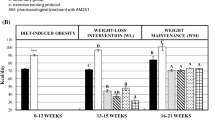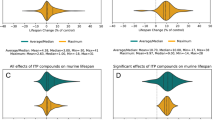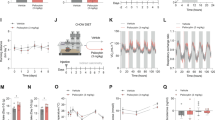Abstract
Objective:
The health and longevity effects of body weight reduction resulting from exercise and caloric restriction in rodents are well known, but less is known about whether similar effects occur with weight reduction from the use of a pharmaceutical agent such as sibutramine, a serotonin-norepinephrine reuptake inhibitor.
Results and conclusion:
Using data from a 2-year toxicology study of sibutramine in Sprague-Dawley CD rats and CD-1 mice, despite a dose-dependent reduction in food intake and body weight in rats compared with controls, and a body weight reduction in mice at the highest dose, there was no compelling evidence for reductions in mortality rate.
This is a preview of subscription content, access via your institution
Access options
Subscribe to this journal
Receive 12 print issues and online access
$259.00 per year
only $21.58 per issue
Buy this article
- Purchase on SpringerLink
- Instant access to full article PDF
Prices may be subject to local taxes which are calculated during checkout


Similar content being viewed by others
References
Allison DB, Downey M, Atkinson RL, Billington CJ, Bray GA, Eckel RH et al. Obesity as a disease: a white paper on evidence and arguments commissioned by the Council of the Obesity Society. Obesity (Silver Spring) 2008; 16: 1161–1177.
Vasselli JR, Weindruch R, Heymsfield SB, Pi-Sunyer FX, Boozer CN, Yi N et al. Intentional weight loss reduces mortality rate in a rodent model of dietary obesity. Obes Res 2005; 13: 693–702.
Adams TD, Gress RE, Smith SC, Halverson RC, Simper SC, Rosamond WD et al. Long-term mortality after gastric bypass surgery. N Engl J Med 2007; 357: 753–761.
Sjostrom L, Narbro K, Sjostrom CD, Karason K, Larsson B, Wedel H et al. Effects of bariatric surgery on mortality in Swedish obese subjects. N Engl J Med 2007; 357: 741–752.
von HS, Lainscak M, Anker SD . Sibutramine in cardiovascular disease: is SCOUT the new STORM on the horizon? Eur Heart J 2007; 28: 2830–2831.
Arterburn DE, Crane PK, Veenstra DL . The efficacy and safety of sibutramine for weight loss: a systematic review. Arch Intern Med 2004; 164: 994–1003.
Caterson I, Coutinho W, Finer N, Van GL, Maggioni A, Torp-Pedersen C et al. Early Response to Sibutramine in Patients Not Meeting Current Label Criteria: Preliminary Analysis of SCOUT Lead-in Period. Obesity (Silver Spring) 2009; 18: 987–994.
Torp-Pedersen C, Caterson I, Coutinho W, Finer N, Van GL, Maggioni A et al. Cardiovascular responses to weight management and sibutramine in high-risk subjects: an analysis from the SCOUT trial. Eur Heart J 2007; 28: 2915–2923.
National Toxicology Program. Toxicology and Carcinogenesis Studies of Ephedrine Sulphate. National Toxicology Program: Technical Report Series 2010. No. 307 1–188. Available from http://ntp.niehs.nih.gov/ntp/htdocs/LT_rpts/tr307.pdf.
Janiak P, Poirier B, Bidouard JP, Cadrouvele C, Pierre F, Gouraud L et al. Blockade of cannabinoid CB1 receptors improves renal function, metabolic profile, and increased survival of obese Zucker rats. Kidney Int 2007; 72: 1345–1357.
ClinicalTrials gov. Comprehensive Rimonabant Evaluation Study of Cardiovascular ENDpoints and Outcomes (CRESCENDO), 2009, August 27 [cited 14 April 2010]; Available from http://www.clinicaltrials.gov/ct/show/NCT00263042.
Van Gaal LF, Caterson ID, Coutinho W, Finer N, Maggioni AP, Sharma AM et al. Weight and blood pressure response to weight management and sibutramine in diabetic and non-diabetic high-risk patients: an analysis from the 6-week lead-in period of the sibutramine cardiovascular outcomes (SCOUT) trial. Diabetes Obes Metab 2010; 12: 26–34.
FDA 2009. Early Communication about an Ongoing Safety Review of Meridia (sibutramine hydrochloride), November 20 [cited 14 April 2010]; Available from http://www.fda.gov/Drugs/DrugSafety/PostmarketDrugSafetyInformationforPatientsandProviders/DrugSafetyInformationforHeathcareProfessionals/ucm191650.htm.
FDA 2010. Follow-Up to the November 2009 Early Communication about an Ongoing Safety Review of Sibutramine, Marketed as Meridia, January 21 [cited 14 April 2010]; Available from http://www.fda.gov/Drugs/DrugSafety/PostmarketDrugSafetyInformationforPatientsandProviders/DrugSafetyInformationforHeathcareProfessionals/ucm198206.htm.
Viner RM, Hsia Y, Neubert A, Wong IC . Rise in antiobesity drug prescribing for children and adolescents in the UK: a population-based study. Br J Clin Pharmacol 2009; 68: 844–851.
Russell JC, Proctor SD . Small animal models of cardiovascular disease: tools for the study of the roles of metabolic syndrome, dyslipidemia, and atherosclerosis. Cardiovasc Pathol 2006; 15: 318–330.
Russell JC . Of mice and men, rats and atherosclerosis. Cardiovasc Res 2003; 59: 810–811.
Arum O, Bonkowski MS, Rocha JS, Bartke A . The growth hormone receptor gene-disrupted mouse fails to respond to an intermittent fasting diet. Aging Cell 2009; 8: 756–760.
Bonkowski MS, Dominici FP, Arum O, Rocha JS, Al Regaiey KA, Westbrook R et al. Disruption of growth hormone receptor prevents calorie restriction from improving insulin action and longevity. PLoS One 2009; 4: e4567.
Carlson AJ, Hoelzel F . Apparent prolongation of the life span of rats by intermittent fasting. J Nutr, 1946; 31: 363–375.
Merry BJ . Molecular mechanisms linking calorie restriction and longevity. Int J Biochem Cell Biol 2002; 34: 1340–1354.
McCay CM, Crowell MF . The effect of retarded growth upon the length of life span and upon the ultimate body size. J Nutr 1935; 10: 63–79. Ref Type: Generic.
Masoro EJ . Overview of caloric restriction and ageing. Mech Ageing Dev 2005; 126: 913–922.
Minor RK, Chang JW, de CR . Hungry for life: How the arcuate nucleus and neuropeptide Y may play a critical role in mediating the benefits of calorie restriction. Mol Cell Endocrinol 2009; 299: 79–88.
Speakman JR, Hambly C . Starving for life: what animal studies can and cannot tell us about the use of caloric restriction to prolong human lifespan. J Nutr 2007; 137: 1078–1086.
Orentreich N, Matias JR, DeFelice A, Zimmerman JA . Low methionine ingestion by rats extends life span. J Nutr 1993; 123: 269–274.
Zimmerman JA, Malloy V, Krajcik R, Orentreich N . Nutritional control of aging. Exp Gerotol 2003; 38: 47–52.
Hasek BE, Stewart LK, Henagan TM, Boudreau A, Lenard NR, Black C et al. Dietary methionine restriction enhances metabolic flexibility and increases uncoupled respiration in both fed and fasted states. Am J Physiol Regul Integr Comp Physiol 2010; 299: R728–R739.
Plaisance EP, Henagan TM, Echlin H, Boudreau A, Hill KL, Lenard NR et al. Role of {beta}-adrenergic receptors in the hyperphagic and hypermetabolic responses to dietary methionine restriction. Am J Physiol Regul Integr Comp Physiol 2010; 299: R740–R750.
Acknowledgements
We thank Michelle Feese, Chasity Bender and Elizabeth Eadie for assistance with data entry and Dr Kyle Grimes for editorial assistance in manuscript preparation. This study was supported in part by NIH grants P30DK056336, P60DK079626, R01AG033682, T32DK062710, and T32HL079888. The opinions expressed herein are those of the authors and not necessarily those of the NIH or any other organization with which the authors are affiliated.
Author information
Authors and Affiliations
Corresponding author
Ethics declarations
Competing interests
DBA has received book royalties, grants, consulting fees, and donations from multiple profit and non-profit entities with interests in obesity, including pharmaceutical companies which compete with the manufacturers of sibutramine and from the manufacturers of sibutramine. TRN has received grants and consulting fees from profit entities with interests in obesity and owns common stock in other profit entities with interests in obesity, including companies that compete with the manufacturers of sibutramine. The remaining authors declare no conflict of interest.
Additional information
Supplementary Information accompanies the paper on International Journal of Obesity website
Supplementary information
Rights and permissions
About this article
Cite this article
Smith, D., Robertson, H., Desmond, R. et al. No compelling evidence that sibutramine prolongs life in rodents despite providing a dose-dependent reduction in body weight. Int J Obes 35, 652–657 (2011). https://doi.org/10.1038/ijo.2010.247
Received:
Revised:
Accepted:
Published:
Issue date:
DOI: https://doi.org/10.1038/ijo.2010.247



